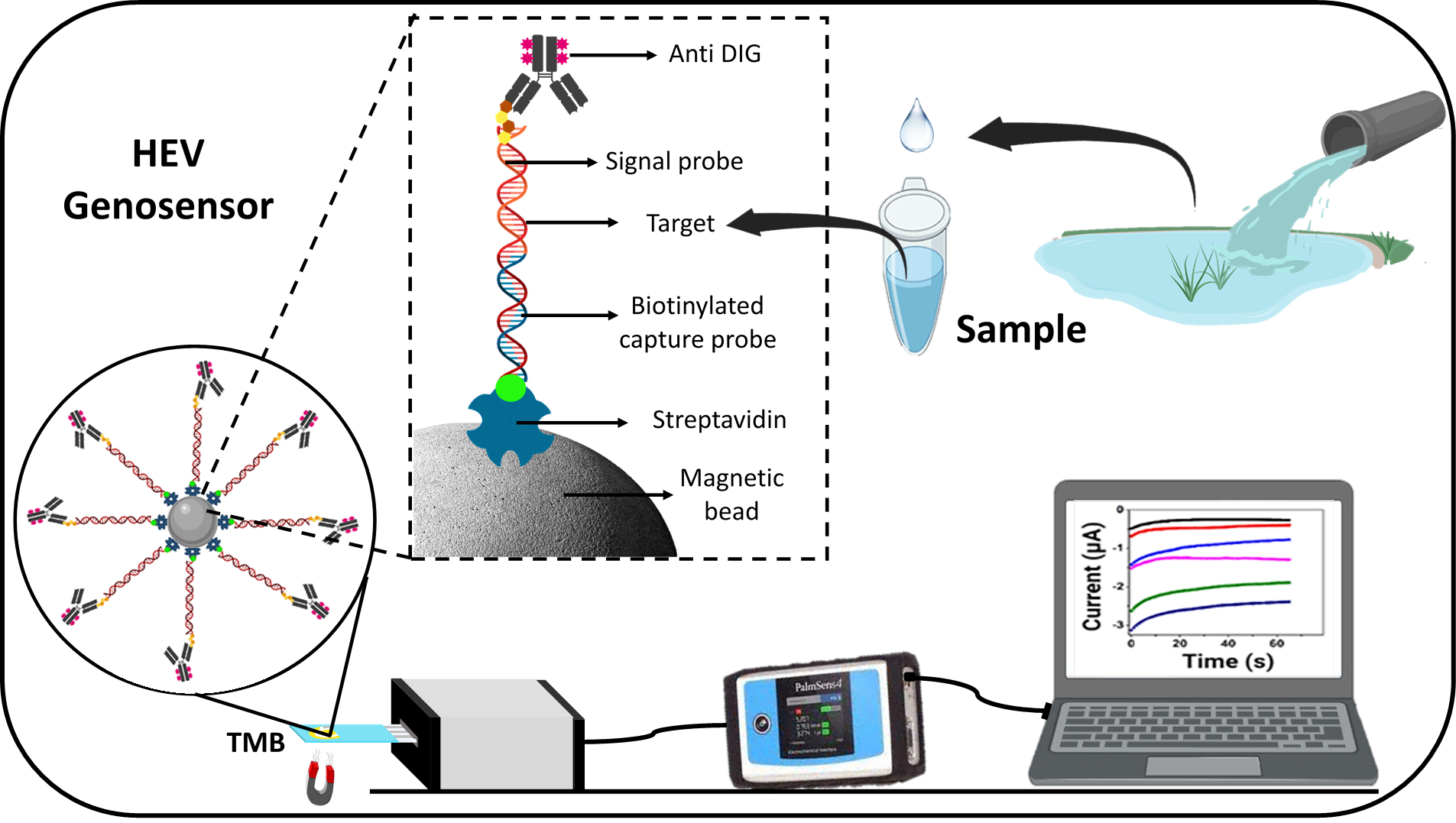Infections caused by Hepatitis E Virus (HEV) have become more frequent in the last ten years, being HEV from serotype 3 the most prevalent virus identified in humans, pigs, and environmental samples in non-endemic regions. Therefore, public health authorities are concerned about viral genome detection in wastewater. Electrochemical biosensors are promising analytical tools for viral genome detection in outside settings. Electrochemical biosensors are autonomous detection devices that integrate materials and biomolecules coupled with simple chips that transform bioreceptor-biomarkers physical, chemical, or biological interactions into measurable electrochemical signals. These devices are characterized by high sensitivity, low detection limit, and high specificity. Therefore, they have demonstrated their potential for rapidly screening patients infected with endemic or emerging viruses [1-5]. However, they also offer an easy-to-implement strategy for developing control and surveillance systems, which is much less explored.
Recently, a joined collaborative effort put together the expertise of Dr. Cristina Navas in virology and HEV and the broad experience of Dr. Jahir Orozco in biosensors, both from the University of Antioquia (Colombia). It came with a publication on a highly specific, sensitive and portable electrochemical genosensor to detect HEV genotype 3 in wastewater samples for the first time [6]. Dr. Navas’ laboratory aligned and analyzed HEV genotype 3 genome sequences available in GenBank and designed highly specific conserved genome regions of HEV as a target to hybridize with capture and signal probes, and empirically tested the specificity. Magnetic particles coated with a biotinylated capture probe hybridized the target and a digoxigenin-signal probe further coupled to an anti-digoxigenin-antibody labeled with horseradish peroxidase (HRP) for electrochemical reading in a portable potentiostat in Dr. Orozco´s laboratory. The electrochemical response of the genosensor with synthetic HEV was target concentration-dependent with high reproducibility and detected the HEV viral genome in real wastewater samples from three municipalities of the Antioquian region, previously characterized in a study led by Dr. Navas’ lab [7]. Furthermore, the genosensor discriminated the HEV genome from the Newcastle disease virus (NDV), Middle East respiratory syndrome coronavirus (MERS-CoV), Severe acute respiratory syndrome coronavirus (SARS-CoV) and Severe acute respiratory syndrome coronavirus type 2 (SARS-CoV-2) genomes.
Therefore, the genosensing platform offers a step forward in the epidemiologic surveillance of this virus and paves the way to develop genosensors to detect other viruses such as the SARS-CoV-2 in wastewater as a warning system.
Read the full article (Anal Chim Acta. 2022 Aug 15;1221:340121.): DOI: 10.1016/j.aca.2022.340121
References
- Daniel Alzate, Sebastián Cajigas, Sara Robledo, Carlos Muskus, Jahir Orozco, Genosensors for differential diagnosis of zika virus. Talanta 210 (2020) 120648.
- Cajigas Sebastián, Alzate Daniel, Jahir Orozco. Gold/DNA-based nanobioconjugate for electrochemical detection of zika virus. Microchimica Acta 187:594 (2020).
- Sebastian Cajigas, Daniel Alzate, Maritza Fernández, Carlos Muskus, Jahir Orozco Electrochemical genosensor for the specific detection of SARS-CoV-2. Talanta 245 (2022) 123482.
- Dayana Soto and Jahir Orozco. Peptide-based simple detection of SARS-CoV-2 with electrochemical readout. Analytica Chimica Acta 1205 (2022) 339739.
- Viviana Vásquez, Maria-Cristina Navas, Javier A Jaimes, Jahir Orozco. SARS-CoV-2 Electrochemical immunosensor based on the spike-ace2 complex. Analytica Chimica Acta 1205 (2022) 339718.
- Daniel Alzate, Maria C Lopez-Osorio, Fabián Cortes-Mancera, Maria-Cristina Navas, Jahir Orozco. Hepatitis E virus genotype 3 detection in wastewater by an electrochemical genosensor. Analytica Chimica Acta 1221 (2022) 340121.
- Baez Paula A, Lopez Maria C, Duque-Jaramillo Alejandra, Pelaez Dioselina, Molina Francisco, Navas Maria-Cristina. First evidence of the Hepatitis E virus in environmental waters in Colombia. PLoS One. 2017 May 16;12(5):e0177525.

